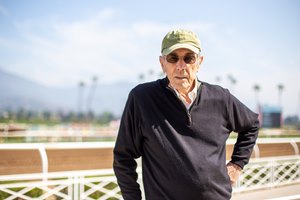CHRB Committee Approves Change in Thyroxine Approvals


A California Horse Racing Board committee has approved a proposed regulatory change intended to curb the growing use of a medication prescribed to treat hypothyroidism, which is rare in racehorses.
According to unanimous action Oct. 21 by the medication, safety, and welfare committee, the full board at its Oct. 22 meeting will consider a requirement that before a veterinarian prescribes thyroxine to a horse at a CHRB-regulated facility, they must have made a hypothyroid diagnosis for the animal based on a thyrotropin-releasing hormone response test. According to information presented to the committee members, the TRH test is the only reliable way to diagnose hypothyroidism.
"Thyroxine has been associated with cardiac arrhythmias and atrial fibrillation in humans and anecdotally similar cardiac arrhythmias and atrial fibrillation have been reported in horses," the board was told in a staff report supporting the TRH test requirement. "The American Association of Equine Practitioners and Racing Medication and Testing Consortium issued a thyroxine advisory in August noting the practice of prescribing levothyroxine to large numbers of racehorses has drawn scrutiny and raised questions about the legitimacy of its use in horses engaged in training and racing. They also pointed to multiple instances where records indicate levothyroxine was prescribed for every horse in a trainer's care."
Dr. Rick Arthur, the equine medical director, explained that following a rash of equine fatalities in 2013, the board took steps to tighten the use of the medication.
"Subsequent to the sudden deaths reports where all the horses in a particular cluster we were investigating were on thyroxine, the board issued an advisory requiring specific diagnostic and other prescribing and reporting and labeling restrictions for thyroxine and any other thyroid hormone or thyroid hormone analogs," Arthur explained.

The staff report and analysis noted that despite those efforts, there have been 256 prescriptions written for thyroxine through the first week in October at Southern California Thoroughbred tracks and their auxiliary training centers.
"Over half of the prescriptions are for two trainers, and 80% of the thyroxine has been prescribed by just three veterinarians," the report stated. "Hypothyroidism is rare in horses and especially so in young racehorses."
"There is no room for the use of thyroxine in racehorses," said Dr. Greg Ferraro, an equine veterinarian and the CHRB chairman. "This ruling is long overdue."
The committee also approved a change to a regulation scheduled to go into effect Jan. 1, 2021, regarding when horses can be removed from the official veterinarian's list that consists of horses deemed to be unfit to compete in a race due to veterinary treatment, physical distress, injury, lameness, unsoundness, or infirmity.
The new regulation, approved by the California Assembly this year, also specifies the amount of time a horse must spend on the veterinarian's list. The committee Wednesday approved a recommendation that the regulation also allow the official veterinarian to require diagnostic imaging prior to removal from the list.
The committee also received a report on postmortem exams conducted during the July 1, 2018, through June 30, 2019, fiscal year that showed 144 examinations were performed, six more than the previous year. Of the equine fatalities during the period, 126 were in Thoroughbreds and 18 in Quarter Horses.
"The largest cluster of fatal injuries—77%—occurred in 2-, 3-, and 4-year-old racehorses," the report stated. "In 2018-19, 79% of the total primary injuries in all breeds were due to musculoskeletal, which is consistent with what has started several years ago."
Arthur also presented the medication violations report for fiscal 2019-20 that showed 119 medication or drug violations, 99 of which were for Class 4 or 5 medications and 20 for Class 1, 2, or 3 medications.
The committee discussed but held off on a vote until further consideration is given to proposed changes in its fire prevention regulation that would remove many of the specifics that must be met before clearance is given prior to a race meet or opening of a training center each year.
Each facility under the CHRB regulatory umbrella would have to receive approval of fire clearances from local fire authorities, the proposal said.
"Board Rule 1927 has existed since the development of the first CHRB regulations and has never been modified. Additionally, based on recommendation from feedback from stakeholders, it is determined that this rule is outdated and difficult to comply with," the analysis stated. "Board staff spoke with the Department of Forestry and Fire Protection regarding the requirements of Board Rule 1927 and the best way to safely amend the rule to make compliance possible for racing associations, but also to ensure continued safety. Upon the recommendation of Cal Fire, it was recommended that the Board leave the approval of the fire clearances up to the local fire authorities and the requirements as outlined in already existing Cal Fire regulations."
After hearing feedback from representatives of racing associations and the general public, the committee decided to continue to work on the proposed changes.
